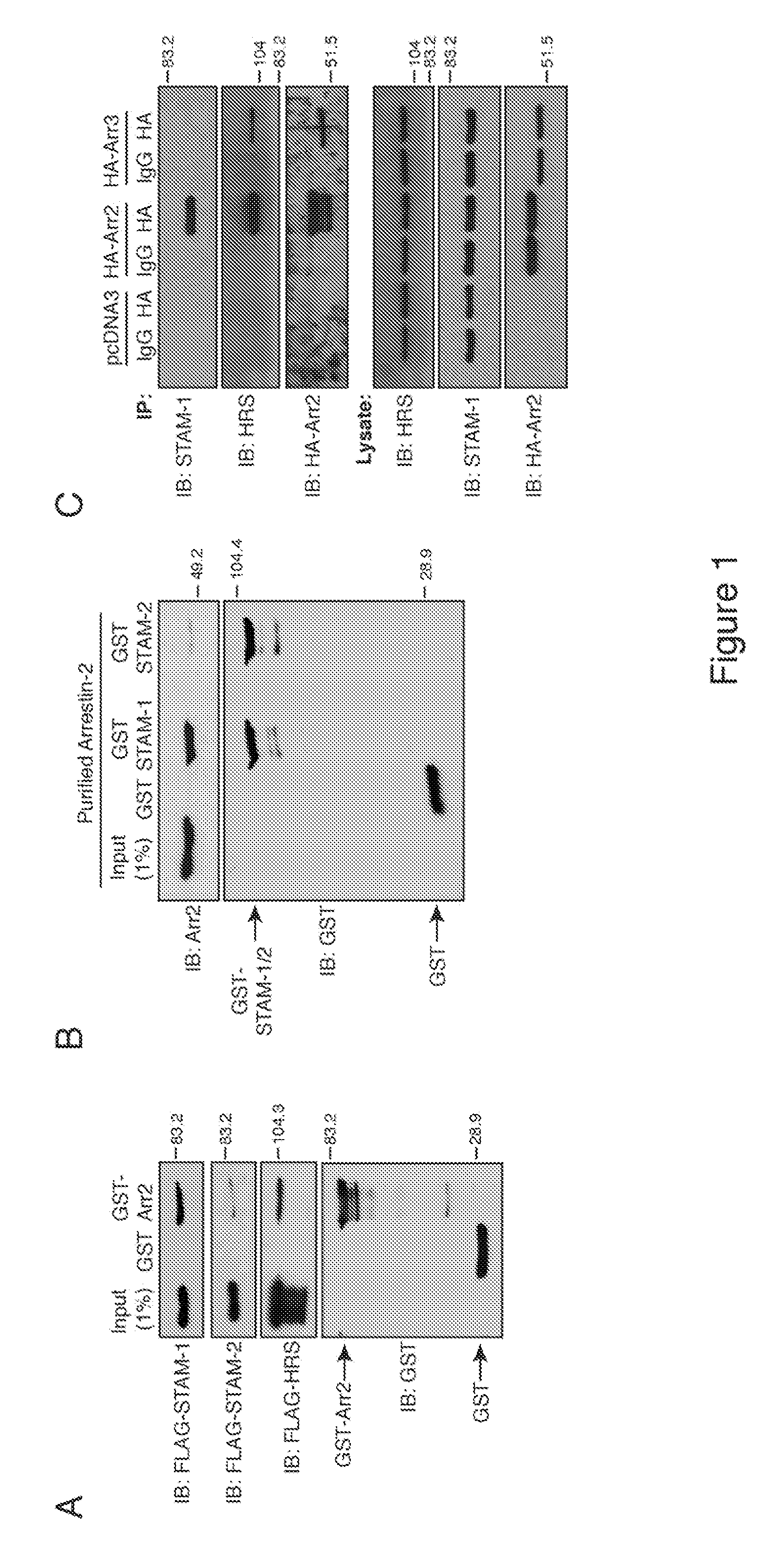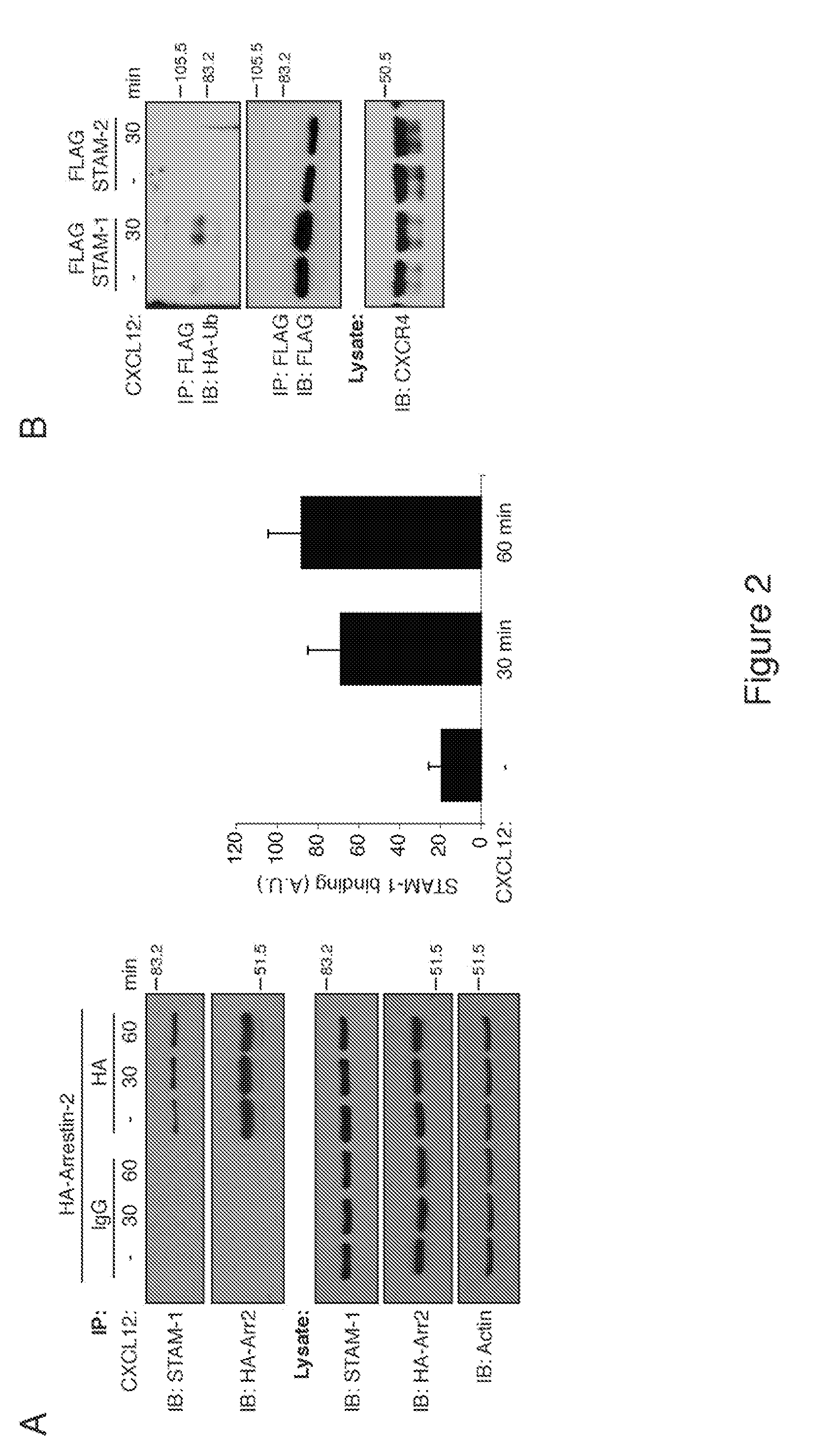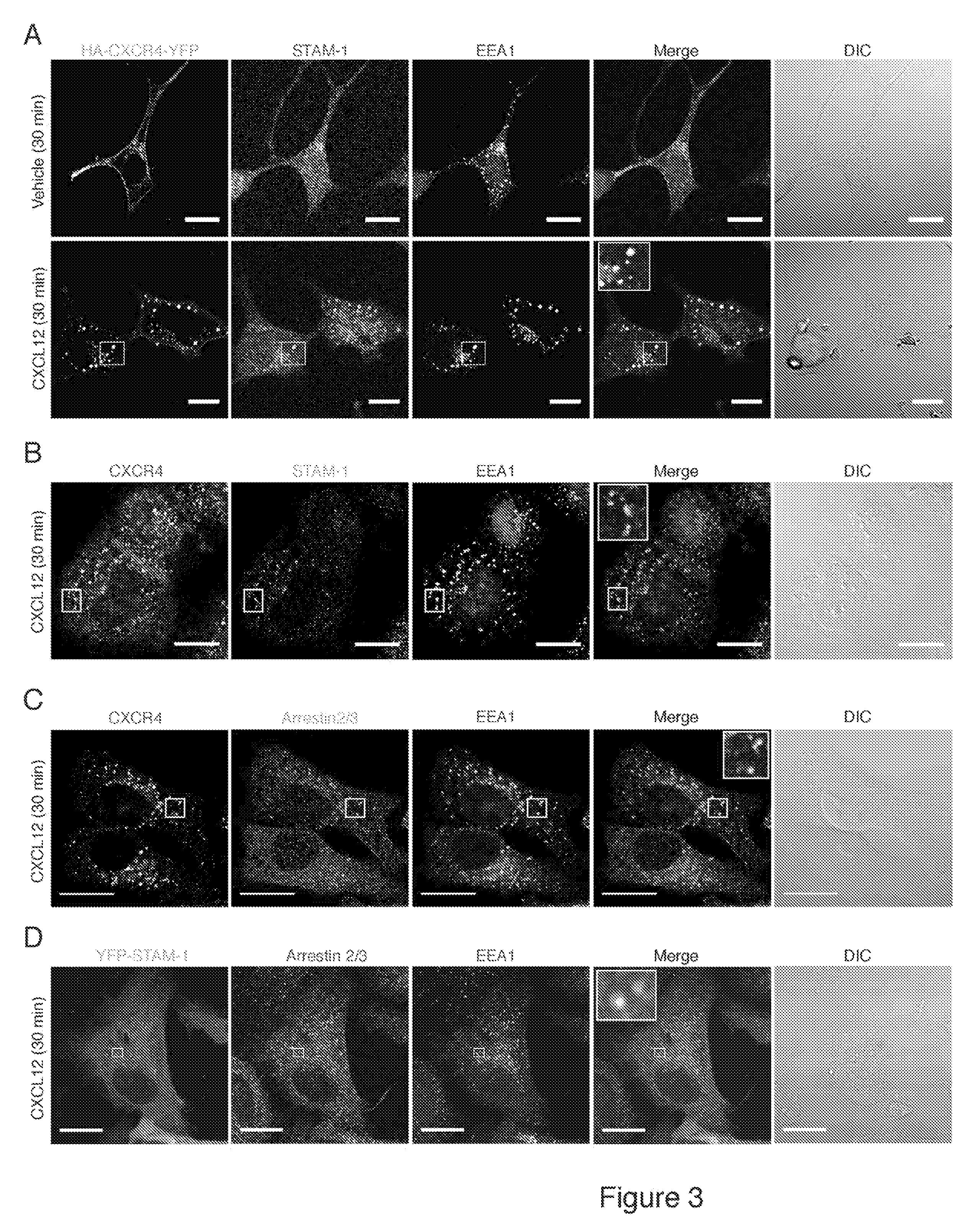[0013]A technical effect of the invention is the ability to interact arrestin-2 with the ESCRT machinery to modulate endosomal sorting of CXCR4. In particular, an interaction between the adaptor proteins arrestin-2 and STAM-1 has been identified that enables the arrestin-2 / STAM-1 complex to be used as a therapeutic target to modulate CXCR4 levels and to modulate CXCL12-evoked
cell migration, which can be extended to use of the arrestin-2 / STAM-1 complex to identify and develop novel pharmacological agents capable of targeting the arrestin-2 / STAM-1 interaction for therapeutic intervention. In a particular example, the arrestin-2 / STAM-1 interaction may be blocked or otherwise disrupted, which can have therapeutically beneficial effects, for example, in the treatment of
metastasis in
cancer patients, and particularly cancers that have elevated levels of CXCR4 in the
tumor cells.
[0014]Data obtained from investigations leading to the invention have indicated that the arrestin-2 / STAM-1 complex serves to negatively regulate the cellular levels of CXCR4 upon activation with its cognate ligand (CXCL12), in other words, stabilizes CXCR4 levels in cells. In particular, interaction regions have been mapped between STAM-1 and arrestin-2 in both proteins, and over-expression of these regions in cells has been shown to disrupt the interaction and accelerate CXCR4 degradation. Over-expression of these regions has also been shown to inhibit CXCL12 evoked
cell migration, while leaving signaling to
extracellular regulated kinases 1 and 2 intact. As such, the arrestin-2 / STAM-1 complex potentially represents a highly useful cellular target to decrease CXCR4 levels and to modulate
cell migration by intentionally mediating the interaction between arrestin-2 and STAM-1, while leaving a subset of the
intracellular signaling cascades and other functions of CXCR4 intact. As such, targeting the arrestin-2 / STAM-1 complex may be particularly useful to inhibit migration of
tumor cells, and thus
metastasis, in patients who have cancers in which CXCR4 levels are elevated. The interface mediating the interaction between arrestin-2 and STAM-1 may be further useful as a target to develop and identify pharmacological agents that may disrupt the interaction between arrestin-2 and STAM-1, with the goal of using them as therapeutics to treat diseases in which reducing CXCR4 level / signaling and migration would be beneficial.
[0015]Prior art methods of modulating CXCR4 signaling have directly targeted CXCR4, thereby affecting all
intracellular signaling pathways activated by CXCR4 and thus may have many unintended consequences. In contrast, the present invention targets the recently discovered arrestin-2 / STAM-1 protein complex that shows specificity to a subset of CXCR4 related signaling and functional events. Therefore, another
advantage of the invention is that side effects or unintended consequences are likely to be minimized by targeting the arrestin-2 / STAM-1 complex. Also, by targeting the intracellular arrestin-2 / STAM-1 complex, accelerated
agonist-promoted degradation of CXCR4 occurs and
cell migration can be inhibited. No other targets and / or agents that have this
dual effect on CXCR4 degradation / migration are believed to be known. In addition, the capability to modulate both of these endpoints with a high degree of specificity would be particularly important outcomes for treating tumor metastasis.
[0016]The use of pharmacological agents that target the arrestin-2 / STAM-1 complex may also be applicable to the treatment of other aspects related to
cancer, such as
tumor cell invasion, proliferation and
angiogenesis. Additional potential uses of the arrestin-2 / STAM-1 complex include the treatment of HIV / AIDS infection, WHIM (wart, hypogammaglobulinemia, infection, and myelokathexis) syndrome and
opioid induced
hyperalgesia. In each of these diseases, by targeting the arrestin-2 / STAM-1 complex and enhancing CXCR4 degradation, decreased cellular levels of CXCR4 may reduce HIV infection, decrease CXCR4 signaling observed in WHIM syndrome patients and reduce pain in patients who suffer from
opioid-induced
hyperalgesia. In addition, targeting the arrestin-2 / STAM-1 may be beneficial to treat highly metastatic cancers that are not CXCR4-dependent, such as those that have increased or amplified
epidermal growth factor receptor expression.
[0017]Other potential therapeutic uses for targeting the arrestin-2 / STAM-1 complex include the treatment of patients who suffer from cardiac and
lung ischemia. Immediately after a cardiac ischemic event, cells in the heart release SDF-1α (the cognate ligand of CXCR4). Release of SDF-1α appears to mobilize
progenitor cells in the
bone marrow to travel to the ischemic site in the heart, where they initiate cardiac
tissue repair in an attempt to restore cardiac function. The
bone marrow-derived cells express CXCR4 and travel to the site of injury in response to the presence of SDF-1α released after the ischemic event. Increasing the mobilization of cells and improving their
motility in response to SDF-1α could potentially increase the mobilization of
bone marrow derived cells to the site of injury, with the potential for enhancing the repair mechanisms and benefiting individuals who suffer from
cardiac ischemia following a heart
attack. In that the invention identifies the arrestin-2 / STAM-1 complex as a therapeutic target to modulate CXCR4 levels and CXCL12-evoked
cell migration, a beneficial effect of enhancing the interaction may be the ability to improve
cell mobility and increase the ability of bone marrow-derived
progenitor cells to travel to the heart to initiate
tissue repair. As such, while disrupting / blocking the arrestin-2 / STAM-1 interaction is believed to be therapeutically beneficial for certain treatments, such as in the treatment of cancer, enhancing / promoting the interaction may be therapeutically beneficial as a treatment for
cardiac ischemia.
[0018]Other aspects and advantages of this invention will be better appreciated from the following detailed description.
 Login to View More
Login to View More 


